
We wrap up the current trail with a reflection of where trends in the cinema industry have taken us in recent decades – three sequels, and one remake/sequel. The concept of the “franchise” has become something of a norm for the animated feature. The use of comfortable, familiar characters not only guarantees a certain degree of easy return on investment from those faithful to the recognizable faces and personalities, but saves on the risk and expense of developing new characters, hiring new talent to provide their voice roles, and working up a creative-enough plot to draw in an unfamiliar audience. Considering that the proliferation of modern-day animated features has resulted in many a first-time flop and on occasion the instant ruination of a studio trying to get on its feet, a franchise provides a much more comfortable position for investors than an untried idea with untested personalities, and in many instances, further provides a means of covering for a potentially lackluster script by masking it with the snappy banter and one-liners of familiar voices. True, there are some, such as Pixar, who remain willing to put their back into projects reusing their signature characters, to provide new storylines in different directions that often remain fresh and exciting in their own right. But others (at least one example of which appears below) exemplify the old adage that “the sequel is never the equal”, a rule only the best have demonstrated can be broken on occasion.
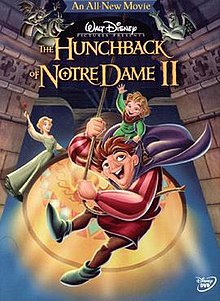 The Hunchback of Notre Dame 2 (Disney, direct-to-video, 3/19/02) – The title alone almost makes one cringe. This film was produced at an unfortunate time when Disney executives were of the belief that every Disney animated feature should be sequelized – whether it needed to be or not. Sometimes the original film would seem to make a sequel impossible, resulting in some projects becoming mid-quels (such as Bambi 2 and The Fox and the Hound 2). Sometimes a film would be exploited with both a sequel and a pre-quel (as in the instance of “The Little Mermaid 2 and 3″), while others would be produced as if presented in a parallel universe to the original film (including “Cinderella 3″ and “The Lion King 1 1/2″). Oh, what we addicts to Disney product endured! While a few projects admittedly turned out okay (including sequels to Peter Pan and The Jungle Book which were re-routed to big-screen releases at the last minute), others were strictly desperation efforts to make a quick buck. Animation quality generally was inconsistent and failed to live up to theatrical standards, only certain scenes seeming to be dressed up as a cut above television animation, while other shots looked sketchy, roughshod, and animated on-the-two’s. On a few occasions, the “sequel” actually was nothing but a string of unaired television pilots sewn together – including “Cinderella 2″ and “AtlantisL Milo’s Return”, reducing everything to only television quality. Amazingly, we were spared any attempt at Snow White or Pinocchio 2 (Filmation already having treaded such ground, as discussed last week), though such Holy Grails have recently fallen prey to the latest Disney trend of remaking all animated features in “live-action”. The 2-D sequel craze came to an end during the promotion of the never-completed “Dumbo 2″, which was plugged on video releases with a “behind-the-scenes” video Interviewing persons in the production staff and showing some unappealing preliminary concept art but no completed animation. What little we saw looked too juvenile by half, and we are probably fortunate to have been spared the purchase or rental of this scrapped scenario.
The Hunchback of Notre Dame 2 (Disney, direct-to-video, 3/19/02) – The title alone almost makes one cringe. This film was produced at an unfortunate time when Disney executives were of the belief that every Disney animated feature should be sequelized – whether it needed to be or not. Sometimes the original film would seem to make a sequel impossible, resulting in some projects becoming mid-quels (such as Bambi 2 and The Fox and the Hound 2). Sometimes a film would be exploited with both a sequel and a pre-quel (as in the instance of “The Little Mermaid 2 and 3″), while others would be produced as if presented in a parallel universe to the original film (including “Cinderella 3″ and “The Lion King 1 1/2″). Oh, what we addicts to Disney product endured! While a few projects admittedly turned out okay (including sequels to Peter Pan and The Jungle Book which were re-routed to big-screen releases at the last minute), others were strictly desperation efforts to make a quick buck. Animation quality generally was inconsistent and failed to live up to theatrical standards, only certain scenes seeming to be dressed up as a cut above television animation, while other shots looked sketchy, roughshod, and animated on-the-two’s. On a few occasions, the “sequel” actually was nothing but a string of unaired television pilots sewn together – including “Cinderella 2″ and “AtlantisL Milo’s Return”, reducing everything to only television quality. Amazingly, we were spared any attempt at Snow White or Pinocchio 2 (Filmation already having treaded such ground, as discussed last week), though such Holy Grails have recently fallen prey to the latest Disney trend of remaking all animated features in “live-action”. The 2-D sequel craze came to an end during the promotion of the never-completed “Dumbo 2″, which was plugged on video releases with a “behind-the-scenes” video Interviewing persons in the production staff and showing some unappealing preliminary concept art but no completed animation. What little we saw looked too juvenile by half, and we are probably fortunate to have been spared the purchase or rental of this scrapped scenario.
 As for “Hunchback”, wipe away all memories of Victor Hugo. A trite and contrived storyline attempts to answer what is practically the only unanswered question left by Disney’s unconventional theatrical original – Will Quasimodo ever find love? I picked this film up used from a video budget rack decades ago, but never got past its first ten minutes, so finally sat down to see it for the first time for this article. Though I’ve certainly seen worse, the experience was not heart-warming or full of trademark Disney charm. Massively distracting from any possible interest in the “love story” or the character personality animation was the central plot vehicle by which to bring Quasi and a girl together – a scheme to steal a massive bell from the towers of Notre Dame? Come on, now! More improbable yet is the reason for the bell’s desirability – it is encrusted with priceless jewels – on the inside? The thought of applying jewels to the surface of a bell seems itself startlingly unlikely, even had they been placed upon its outer walls, as there is no telling what such a coating would do to the bell’s tone. Wouldn’t the bell rattle and crackle like crazy, while muffling the internal vibrations with the added coating? But placing the jewels inside the bell’s walls? First, what’s the point, if no one’s going to see them unless they’re standing in or under it? And second, what happens to the bell’s clapper? It’s either going to make some massive dents in all that wealth, or, even if it hits below the encrustation, cause enough tremors to rattle a small fortune in shiny trinkets out of its shell with each bong.
As for “Hunchback”, wipe away all memories of Victor Hugo. A trite and contrived storyline attempts to answer what is practically the only unanswered question left by Disney’s unconventional theatrical original – Will Quasimodo ever find love? I picked this film up used from a video budget rack decades ago, but never got past its first ten minutes, so finally sat down to see it for the first time for this article. Though I’ve certainly seen worse, the experience was not heart-warming or full of trademark Disney charm. Massively distracting from any possible interest in the “love story” or the character personality animation was the central plot vehicle by which to bring Quasi and a girl together – a scheme to steal a massive bell from the towers of Notre Dame? Come on, now! More improbable yet is the reason for the bell’s desirability – it is encrusted with priceless jewels – on the inside? The thought of applying jewels to the surface of a bell seems itself startlingly unlikely, even had they been placed upon its outer walls, as there is no telling what such a coating would do to the bell’s tone. Wouldn’t the bell rattle and crackle like crazy, while muffling the internal vibrations with the added coating? But placing the jewels inside the bell’s walls? First, what’s the point, if no one’s going to see them unless they’re standing in or under it? And second, what happens to the bell’s clapper? It’s either going to make some massive dents in all that wealth, or, even if it hits below the encrustation, cause enough tremors to rattle a small fortune in shiny trinkets out of its shell with each bong.
Was no one among Disney’s substantial staff able to see these problems? More likely, they just didn’t care. It’s fun to imagine the remarks that might have been elicited, and the heads that might have rolled among the writing staff, if Walt himself had been alive to have final say upon story approval.
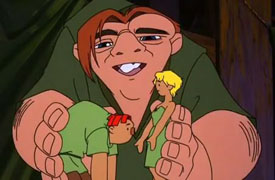 The film takes place several years after the original story. Quasimoto (we’ll call him Qiasi for short) is now a somewhat-accepted member of the community in recognition of his deeds in the first film. No longer a total recluse in the bell tower, he is able to occasionally mingle with the crowds, especially during Paris’s frequent festivals, the latest of which is Le Jour D’Amour, a multi-day event of courtship, climaxed by declarations of mutual love on a podiim while “La Fidele” (the jeweled bell) is rung from the tower. And Quasi has a few close friends – namely, Esmeralda the gypsy girl and Phoebus, Captain of the Guard, who have married thanks to Quasi’s prior help, and begat a young son named Zephyr, with whom Quasi is quite close. Plus, the three talking gargoyles remain Quasi’s secret advisors and provide general encouragement in their own slightly twisted way (overall, the gargoyles’ footage, though only incidental to the plot progression, is by far the most entertaining aspect of the production). But, despite the overall improvement of his life, Quasi still houses one sobering recognition of the realities of life – that La Fidele will never ring for him, as no one is likely to see past his exterior deformity to the point of showing any romantic interest in him. Nevertheless, his friends continue to console, asserting that somewhere there’s someone for everybody, and urging him not to give up hope.
The film takes place several years after the original story. Quasimoto (we’ll call him Qiasi for short) is now a somewhat-accepted member of the community in recognition of his deeds in the first film. No longer a total recluse in the bell tower, he is able to occasionally mingle with the crowds, especially during Paris’s frequent festivals, the latest of which is Le Jour D’Amour, a multi-day event of courtship, climaxed by declarations of mutual love on a podiim while “La Fidele” (the jeweled bell) is rung from the tower. And Quasi has a few close friends – namely, Esmeralda the gypsy girl and Phoebus, Captain of the Guard, who have married thanks to Quasi’s prior help, and begat a young son named Zephyr, with whom Quasi is quite close. Plus, the three talking gargoyles remain Quasi’s secret advisors and provide general encouragement in their own slightly twisted way (overall, the gargoyles’ footage, though only incidental to the plot progression, is by far the most entertaining aspect of the production). But, despite the overall improvement of his life, Quasi still houses one sobering recognition of the realities of life – that La Fidele will never ring for him, as no one is likely to see past his exterior deformity to the point of showing any romantic interest in him. Nevertheless, his friends continue to console, asserting that somewhere there’s someone for everybody, and urging him not to give up hope.
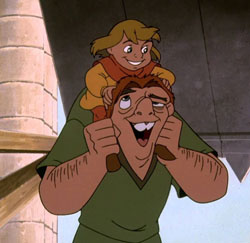 Into this setting enters a traveling circus. The troupe is headed by a magician (Sarousch), definitely a villain, but not one who’s going to win the status of memorable among the vast array of Disney scoundrels. He is utterly conceited with his own appearance (though most of his public image is entirely fake, utilizing a toupee, a corset, etc.), and more of a slithering fast-talker than a genuinely threatening figure. He uses the circus as a cover to distract the attending public’s attention from a pickpocketing ring under Sarousch’s command, who rob the patrons blind while their eyes are glued on the show. Sarousch’s biggest illusion is causing a full-grown elephant to vanish under a cloak. (Again, limits of plausibility are far exceeded, not only by the trick, but by the entrance of the elephant – carried in atop a wooden platform, on the shoulders of only two handlers?) Also among Sarousch’s troupe is a young gitl named Madelaine, whom Sarousch keeps under his psychological thumb by holding over her a moral obligation for taking her in off the Paris streets as an orphan when she was only six, and a threat of bringing up to the police her childhood crime of stealing from him at the time, if she crosses him. Madelaine aspires to learn high-wire balancing, but Sarousch is content with limiting her performing skills to just standing there and looking pretty, to distract the crowd’s attention from how his tricks are performed. More importantly, Madelaine is now ordered to use her looks and appeal for a different purpose – to look up the bell ringer at Notre Dame, and work her wiles to determine which of the bells is La Fidele – as Sarousch intends to steal it before leaving Paris.
Into this setting enters a traveling circus. The troupe is headed by a magician (Sarousch), definitely a villain, but not one who’s going to win the status of memorable among the vast array of Disney scoundrels. He is utterly conceited with his own appearance (though most of his public image is entirely fake, utilizing a toupee, a corset, etc.), and more of a slithering fast-talker than a genuinely threatening figure. He uses the circus as a cover to distract the attending public’s attention from a pickpocketing ring under Sarousch’s command, who rob the patrons blind while their eyes are glued on the show. Sarousch’s biggest illusion is causing a full-grown elephant to vanish under a cloak. (Again, limits of plausibility are far exceeded, not only by the trick, but by the entrance of the elephant – carried in atop a wooden platform, on the shoulders of only two handlers?) Also among Sarousch’s troupe is a young gitl named Madelaine, whom Sarousch keeps under his psychological thumb by holding over her a moral obligation for taking her in off the Paris streets as an orphan when she was only six, and a threat of bringing up to the police her childhood crime of stealing from him at the time, if she crosses him. Madelaine aspires to learn high-wire balancing, but Sarousch is content with limiting her performing skills to just standing there and looking pretty, to distract the crowd’s attention from how his tricks are performed. More importantly, Madelaine is now ordered to use her looks and appeal for a different purpose – to look up the bell ringer at Notre Dame, and work her wiles to determine which of the bells is La Fidele – as Sarousch intends to steal it before leaving Paris.
 The encounter between Madelaine and Quasi generates no true on-screen chemistry or heartwarming sensitivity (Oh, how we long for the days of Aladdin and Jasmine), but merely goes through the motions. Madelaine is at first frightened by Quasi’s appearance, but just as suddenly seems to shift gears when she sees that Quasi has a way with kids, in a largely space-filling musical number with Zephyr. She seems to warm to Quasi, apologizing to him, but still goes about her business of finding out which is the right bell, though joining Quasi on a sight-seeing tour of the secret vantage points of Paris. (There again seems to be an Aladdin/Jasmine influence and semi-plagiarism here, as one tour point is a secret scenic view high above the city – almost the same thing as Aladdin’s hidden hideaway shown to Jasmine when he believes her to be a street girl.) It is all strictly by the book, and in the long run, Madelaine still allows herself to be pressured by Sarousch into double-crossing Quasu, revealing the location of the bell to Sarousch and allowing for the set-up of the theft.
The encounter between Madelaine and Quasi generates no true on-screen chemistry or heartwarming sensitivity (Oh, how we long for the days of Aladdin and Jasmine), but merely goes through the motions. Madelaine is at first frightened by Quasi’s appearance, but just as suddenly seems to shift gears when she sees that Quasi has a way with kids, in a largely space-filling musical number with Zephyr. She seems to warm to Quasi, apologizing to him, but still goes about her business of finding out which is the right bell, though joining Quasi on a sight-seeing tour of the secret vantage points of Paris. (There again seems to be an Aladdin/Jasmine influence and semi-plagiarism here, as one tour point is a secret scenic view high above the city – almost the same thing as Aladdin’s hidden hideaway shown to Jasmine when he believes her to be a street girl.) It is all strictly by the book, and in the long run, Madelaine still allows herself to be pressured by Sarousch into double-crossing Quasu, revealing the location of the bell to Sarousch and allowing for the set-up of the theft.
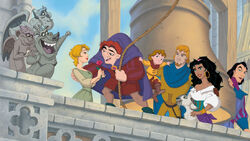 The intrusion into Notre Dame is set-up by Madelaine taking Quasi away on a pretend date, allegedly in her own mind to keep him from getting in the way and potentially getting hurt by Sarouche and his two weight-lifting boys. The theft is absolutely preposterous, with no effort to present how the bell is to be unhooked, carried down narrow flights of stairs, and out through the halls of Notre Dame without so much as a clang. All Sarousch does is throw his elephant cloak over the bell, and with a few magic words make it disappear! After the disappearance, Madelaine of course attempts to prove she is better than what she’s done, by supposedly revealing the secret of Sarousch’s disapparing act, claiming “There’s always a tunnel.” Now just a French-fried minute! Are we to believe that, long before the availability of hydraulics, there was some way to lower an elephant noiselessly into a tunnel in the twinkling of an eye, without a shuddering thud or a trumpet from the beast? And what about the bell? It’s in a high tower, so how do you create a tunnel through multiple stories of scaffolds and the cathedral floor to accommodate it – all again with no clang? Is there any justification left to following this pointless plot further? It also seems that Sarousch has no exit strategy, content with rowing the bell along on a barge from the catacombs beneath the cathedral, emerging in plain view with the shape of the bell in no manner concealed on deck. What were these writers thinking – or were they? Sarousch’s only accidental, unplanned ace in the hole is the arrival of Zephyr at the cathedral to visit Quasi, just when the bad guys are making their exit, allowing Sarousch to use the boy as a hostage, demanding Phoebus grant him safe passage out of the city. Quasi and Madelaine foil this lame plan, by Quasi throwing a rope across the water lane through which the barge will pass, then holding the rope taut, as Madelaine performs her high-wire walk across the water, then hangs from the rope by her feet to reach down and pull Zephyr from the barge deck. (Also amazing that this whole feat can be performed with only one end of the rope tied off, depending entirely upon the strength and steadiness of Quasi’s grip to hold up the rope at the other end. Is this even feasibly possible?) Without the hostage, the royal guards quickly swoop down upon Sarousch with barely a struggle, providing a far-too-sudden wrap-up without plot twist or complication. Quasi and Madelaine declare their love at the festival. (So who is up there ringing La Fidele?) Quasi’s hand-carved figurines of himself and Madelaine stand together on a miniature podium in the tower as witnesses to the event, as we fade out – mercifully.
The intrusion into Notre Dame is set-up by Madelaine taking Quasi away on a pretend date, allegedly in her own mind to keep him from getting in the way and potentially getting hurt by Sarouche and his two weight-lifting boys. The theft is absolutely preposterous, with no effort to present how the bell is to be unhooked, carried down narrow flights of stairs, and out through the halls of Notre Dame without so much as a clang. All Sarousch does is throw his elephant cloak over the bell, and with a few magic words make it disappear! After the disappearance, Madelaine of course attempts to prove she is better than what she’s done, by supposedly revealing the secret of Sarousch’s disapparing act, claiming “There’s always a tunnel.” Now just a French-fried minute! Are we to believe that, long before the availability of hydraulics, there was some way to lower an elephant noiselessly into a tunnel in the twinkling of an eye, without a shuddering thud or a trumpet from the beast? And what about the bell? It’s in a high tower, so how do you create a tunnel through multiple stories of scaffolds and the cathedral floor to accommodate it – all again with no clang? Is there any justification left to following this pointless plot further? It also seems that Sarousch has no exit strategy, content with rowing the bell along on a barge from the catacombs beneath the cathedral, emerging in plain view with the shape of the bell in no manner concealed on deck. What were these writers thinking – or were they? Sarousch’s only accidental, unplanned ace in the hole is the arrival of Zephyr at the cathedral to visit Quasi, just when the bad guys are making their exit, allowing Sarousch to use the boy as a hostage, demanding Phoebus grant him safe passage out of the city. Quasi and Madelaine foil this lame plan, by Quasi throwing a rope across the water lane through which the barge will pass, then holding the rope taut, as Madelaine performs her high-wire walk across the water, then hangs from the rope by her feet to reach down and pull Zephyr from the barge deck. (Also amazing that this whole feat can be performed with only one end of the rope tied off, depending entirely upon the strength and steadiness of Quasi’s grip to hold up the rope at the other end. Is this even feasibly possible?) Without the hostage, the royal guards quickly swoop down upon Sarousch with barely a struggle, providing a far-too-sudden wrap-up without plot twist or complication. Quasi and Madelaine declare their love at the festival. (So who is up there ringing La Fidele?) Quasi’s hand-carved figurines of himself and Madelaine stand together on a miniature podium in the tower as witnesses to the event, as we fade out – mercifully.
 Open Season 3 (Sony Animation, 1/25/11) – This direct-to-video sequel to the theatrical is at least better thought out than Disney’s project above. It benefits from a snappy dialogue script and strong character personalities. It veers some attention away from the “buddy” relationship of the original film, essentially centering attention on Boog, a grizzly bear with much of the same lovable lug traits of Disney’s Baloo. (This is a marked improvement over the previous “Open Season 2″, which seemed to lose its storyline upon minor characters and was disappointing.) The story opens at the dawn of Spring, as Boog, the only one of his kind in the local forest, awakens from hibernation. Being a bachelor, Boog eagerly anticipates the annual ritual of a “guy’s trip” with his forest friends. Unfortunately, this season finds all of his companions either industriously busy on projects (beaver dam building, squirrel nut gathering) or married and saddled with the tasks of bringing up new families, including his best friend, Elliott, the one-antlered deer. Especially with Elliott bowing out rather ungraciously, Boog is peeved that his so-called best friends have deserted him, and after all the little tasks and favors he has done for them with his powerful strength over the years. With only his toy teddy bear as a companion, Boog attempts to console his sorrow by a break-in to the local convenience store after hours, to gorge himself on his favorite candy bars and junk food. Under the influence of a chocolate overdose, Boog voices his dreams to his teddy bear of an ideal world where bears rule and no one breaks their promises and commitments – a Bearvana. He then notices a poster on the wall advertising the Maslova Family Circus playing in town, depicting multiple images of bears performing, and wonders if this fanciful world might be just such the place he dreams of. He does not have far to look for the show, as its searchlights fill the sky in a view straight out the store window.
Open Season 3 (Sony Animation, 1/25/11) – This direct-to-video sequel to the theatrical is at least better thought out than Disney’s project above. It benefits from a snappy dialogue script and strong character personalities. It veers some attention away from the “buddy” relationship of the original film, essentially centering attention on Boog, a grizzly bear with much of the same lovable lug traits of Disney’s Baloo. (This is a marked improvement over the previous “Open Season 2″, which seemed to lose its storyline upon minor characters and was disappointing.) The story opens at the dawn of Spring, as Boog, the only one of his kind in the local forest, awakens from hibernation. Being a bachelor, Boog eagerly anticipates the annual ritual of a “guy’s trip” with his forest friends. Unfortunately, this season finds all of his companions either industriously busy on projects (beaver dam building, squirrel nut gathering) or married and saddled with the tasks of bringing up new families, including his best friend, Elliott, the one-antlered deer. Especially with Elliott bowing out rather ungraciously, Boog is peeved that his so-called best friends have deserted him, and after all the little tasks and favors he has done for them with his powerful strength over the years. With only his toy teddy bear as a companion, Boog attempts to console his sorrow by a break-in to the local convenience store after hours, to gorge himself on his favorite candy bars and junk food. Under the influence of a chocolate overdose, Boog voices his dreams to his teddy bear of an ideal world where bears rule and no one breaks their promises and commitments – a Bearvana. He then notices a poster on the wall advertising the Maslova Family Circus playing in town, depicting multiple images of bears performing, and wonders if this fanciful world might be just such the place he dreams of. He does not have far to look for the show, as its searchlights fill the sky in a view straight out the store window.
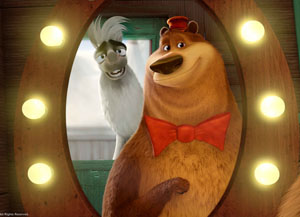 At the circus grounds, the larger animals are treated well, in the manner of performers, with most of them assigned respective gypsy-style dressing wagons without bars, positioned as a perimeter semi-circle around the rear entrance to the main tent. However, the wagons are heavy, with tall curved roofs, making it impossible to move them without the strong arms of multiple animals, and hopeless to gain a sure footing upon to climb over the top. Among the performers are two grizzly bears – a scruffy, sandy-colored male named Doug, former resident of a wild animal park, where he claims to have been treated like a king as the only grizzly on the lot. However, he now plays second-fiddle to Ursa, a plump but pretty female who is an avid acrobatic performer and aspiring bruin ballerina. Doug is fed up with life trying to catch his nimble but weighty partner as she performs graceful aerial leaps off a trampoline, and won’t perform his tricks, letting her fall with a massive plop. Doug confides in his own closest associate, an Argentine llama named Alistair, that he wants to escape to another place where a lone bear can rule. Trouble is, those gypsy carts. He and Alistair are too weak to lift them, too short to climb over them, and too heavy or awkward to use either trampoline or cannon to launch themselves over them. Ursa might have been their only hope for an extra set of arms, but she remains a devoted performer, and will not assist Doug to escape and ruin the show.
At the circus grounds, the larger animals are treated well, in the manner of performers, with most of them assigned respective gypsy-style dressing wagons without bars, positioned as a perimeter semi-circle around the rear entrance to the main tent. However, the wagons are heavy, with tall curved roofs, making it impossible to move them without the strong arms of multiple animals, and hopeless to gain a sure footing upon to climb over the top. Among the performers are two grizzly bears – a scruffy, sandy-colored male named Doug, former resident of a wild animal park, where he claims to have been treated like a king as the only grizzly on the lot. However, he now plays second-fiddle to Ursa, a plump but pretty female who is an avid acrobatic performer and aspiring bruin ballerina. Doug is fed up with life trying to catch his nimble but weighty partner as she performs graceful aerial leaps off a trampoline, and won’t perform his tricks, letting her fall with a massive plop. Doug confides in his own closest associate, an Argentine llama named Alistair, that he wants to escape to another place where a lone bear can rule. Trouble is, those gypsy carts. He and Alistair are too weak to lift them, too short to climb over them, and too heavy or awkward to use either trampoline or cannon to launch themselves over them. Ursa might have been their only hope for an extra set of arms, but she remains a devoted performer, and will not assist Doug to escape and ruin the show.
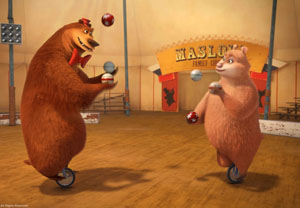 Along comes Boog, peering between the wagons. Boog finds himself eye-to-eye with Doug peering out. Another grizzly! Boog instantly tries to develop a friendship bond, suggesting his favorite “guy’s trip” activities. Boog changes it to “bear’s trip” when he spies Ursa entering her wagon on the opposite end of the wagon circle. Boog lets slip hus having left a forest where he was the lone grizzly – and Doug leaps to the conclusion that this must be a place where he would again be treated like a king. Doug feigns friendship to Boog, and declares his intention to join him, and even bring Ursa along, but for a few fine points. First, they’ll need to find a new location to conduct their bears-only new lifestyle. Secondly, while Doug is looking for such a destination, the circus might miss him, and send out a searching party. Doug suggests that Boog switch places with him temporarily, so that Doug can complete the search undetected, before the three bears make their break for new freedom. Boog is suckered in, and even Alistair falls prey to Doug’s fast talk, as Doug promises to send someone back to switch places with Alistair the following night. With the combined strength of the two bears, the wagon is moved, and the switch takes place, as the wagon is reset in its original position. To complete Boog’s disguise, Doug roughs up the fur on Boog’s head to make him look more unkempt, and Alistair kicks sand into Boog’s fur to make him appear more sandy-brown.
Along comes Boog, peering between the wagons. Boog finds himself eye-to-eye with Doug peering out. Another grizzly! Boog instantly tries to develop a friendship bond, suggesting his favorite “guy’s trip” activities. Boog changes it to “bear’s trip” when he spies Ursa entering her wagon on the opposite end of the wagon circle. Boog lets slip hus having left a forest where he was the lone grizzly – and Doug leaps to the conclusion that this must be a place where he would again be treated like a king. Doug feigns friendship to Boog, and declares his intention to join him, and even bring Ursa along, but for a few fine points. First, they’ll need to find a new location to conduct their bears-only new lifestyle. Secondly, while Doug is looking for such a destination, the circus might miss him, and send out a searching party. Doug suggests that Boog switch places with him temporarily, so that Doug can complete the search undetected, before the three bears make their break for new freedom. Boog is suckered in, and even Alistair falls prey to Doug’s fast talk, as Doug promises to send someone back to switch places with Alistair the following night. With the combined strength of the two bears, the wagon is moved, and the switch takes place, as the wagon is reset in its original position. To complete Boog’s disguise, Doug roughs up the fur on Boog’s head to make him look more unkempt, and Alistair kicks sand into Boog’s fur to make him appear more sandy-brown.
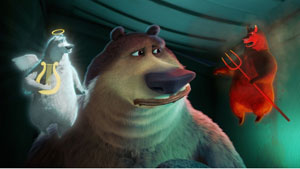 The switch doesn’t go quite as expected. Doug, applying a coat of mud to his own fur to slick it down and darken its color, moves in on Boog’s old digs, but fails to draw the instant respect from the forest creatures he expected. Instead, they pester him for favors, or utter disrespectful remarks. Doug gets fed up with it, and lets out a roar to put the other animals in their place. The others are taken aback at “Boog’s” new attitude, and begin to wonder if they’ve taken him too much for granted. Doug demands some “service”, taking over Boog’s old cave, and attempting to utilize it in the manner of a palace, with all the other animals waiting on him hand and foot. Ultimately, Elliott and his children blow Doug’s cover, spotting his application of the mud and discovering the true shaggy, sandy texture of his fur. Doug still claims his right to rule, and the other animals realize they must try to find Boog. Doug mentions that their old friend will not be around for long, as the Circus will soon be packing up, and shipping out for its home base of – Russia. He envisions Boog as destined to practice to become a polar bear.
The switch doesn’t go quite as expected. Doug, applying a coat of mud to his own fur to slick it down and darken its color, moves in on Boog’s old digs, but fails to draw the instant respect from the forest creatures he expected. Instead, they pester him for favors, or utter disrespectful remarks. Doug gets fed up with it, and lets out a roar to put the other animals in their place. The others are taken aback at “Boog’s” new attitude, and begin to wonder if they’ve taken him too much for granted. Doug demands some “service”, taking over Boog’s old cave, and attempting to utilize it in the manner of a palace, with all the other animals waiting on him hand and foot. Ultimately, Elliott and his children blow Doug’s cover, spotting his application of the mud and discovering the true shaggy, sandy texture of his fur. Doug still claims his right to rule, and the other animals realize they must try to find Boog. Doug mentions that their old friend will not be around for long, as the Circus will soon be packing up, and shipping out for its home base of – Russia. He envisions Boog as destined to practice to become a polar bear.
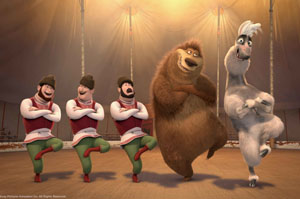 Boog meanwhile occupies his time in trying to befriend Ursa. Her coldness to him is a reflection of her dislike and distrust of Doug, so Boog attempts to lower the mask of disguise, and let her in on his switching places. She at first refuses to believe he is not the stubborn, lazy grizzly she knew, but Boog offers proof by performing various stunts, juggling other animals, and finally following Ursa up to the high wire – a place Doug was always afraid of. Ursa is convinced, but playfully bounces on the wire to cause Boog to fall, stating that he deserves some punishment for juggling other animals. Nevertheless, a friendship begins to develop, especially when she finds Boog is willing to dance in the manner that her ballet scores were intended to be performed. However, another route to friendship disintegrates, as Doug of course fails to return for the promised escape, leaving both Boog and Alistair to develop a bond of sadness at being mutually betrayed, and Boog realizing he may have to live a circus life forever.
Boog meanwhile occupies his time in trying to befriend Ursa. Her coldness to him is a reflection of her dislike and distrust of Doug, so Boog attempts to lower the mask of disguise, and let her in on his switching places. She at first refuses to believe he is not the stubborn, lazy grizzly she knew, but Boog offers proof by performing various stunts, juggling other animals, and finally following Ursa up to the high wire – a place Doug was always afraid of. Ursa is convinced, but playfully bounces on the wire to cause Boog to fall, stating that he deserves some punishment for juggling other animals. Nevertheless, a friendship begins to develop, especially when she finds Boog is willing to dance in the manner that her ballet scores were intended to be performed. However, another route to friendship disintegrates, as Doug of course fails to return for the promised escape, leaving both Boog and Alistair to develop a bond of sadness at being mutually betrayed, and Boog realizing he may have to live a circus life forever.
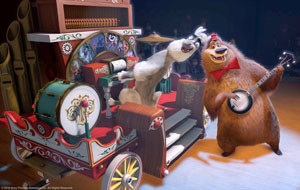 The ending of the film is perhaps its biggest disappointment. It is not well-plotted, substituting chaotic action for real ideas. Doug is eventually chased from his throne by the angry woodland community, and longs to return to his former life of semi-appreciation and three square meals a day with the Circus, never having expected to miss what he already had. The forest animals form a mass rescue party, creeping under the wagons to infiltrate the show. Several of them get mixed up in the acts (one funny idea is a human canonball act where the animal selected for launch is encased in a round metal satellite-ball resembling Sputnik), while Boog and Ursa attempt to finally perform their ballet, amid a chorus of Cirque-de-Soleil style dancers and some impressive black-lighting effects that display Ursa in a starlit costume as Ursa Major. Despite animals flying through the air from the rescue party, dispatching most of the chorus dancers and sending Ursa into a spin in the middle of her leap, Boog successfully catches his partner, bringing the dance to a classy conclusion, and a wide, appreciative smile to Ursa’s face. Boog is torn between his affection for Ursa and his forest friends’ imploring him to make his escape. Boog asks id Ursa will go with him, but Ursa, though wishing she could, declares faithfulness to the show, stating that a Russan circus without a bear is like no circus at all – something she cannot do to the family owners. However, the timely return of Doug (without appropriate explanation of how he got past the wagons) solves the problem, as Doug is now ready to work, and with Ursa wishing to leave with Boog, finds himself in position to become the new star of the show with his partner Alistair. The Maslova family is so impressed by his new performance that they don’t even seem to miss Ursa, and Ursa follows Boog in his return to the forest, the Circus now being secure with its new starring bear. Boog becomes a happily married man – er, bear, but not without remembering the importance of the occasional guy’s trip, with the spouses finally relinquishing their grip on the other married males to allow the series’ principals to leave on their bonding excursion, singing “On the Road Again.”
The ending of the film is perhaps its biggest disappointment. It is not well-plotted, substituting chaotic action for real ideas. Doug is eventually chased from his throne by the angry woodland community, and longs to return to his former life of semi-appreciation and three square meals a day with the Circus, never having expected to miss what he already had. The forest animals form a mass rescue party, creeping under the wagons to infiltrate the show. Several of them get mixed up in the acts (one funny idea is a human canonball act where the animal selected for launch is encased in a round metal satellite-ball resembling Sputnik), while Boog and Ursa attempt to finally perform their ballet, amid a chorus of Cirque-de-Soleil style dancers and some impressive black-lighting effects that display Ursa in a starlit costume as Ursa Major. Despite animals flying through the air from the rescue party, dispatching most of the chorus dancers and sending Ursa into a spin in the middle of her leap, Boog successfully catches his partner, bringing the dance to a classy conclusion, and a wide, appreciative smile to Ursa’s face. Boog is torn between his affection for Ursa and his forest friends’ imploring him to make his escape. Boog asks id Ursa will go with him, but Ursa, though wishing she could, declares faithfulness to the show, stating that a Russan circus without a bear is like no circus at all – something she cannot do to the family owners. However, the timely return of Doug (without appropriate explanation of how he got past the wagons) solves the problem, as Doug is now ready to work, and with Ursa wishing to leave with Boog, finds himself in position to become the new star of the show with his partner Alistair. The Maslova family is so impressed by his new performance that they don’t even seem to miss Ursa, and Ursa follows Boog in his return to the forest, the Circus now being secure with its new starring bear. Boog becomes a happily married man – er, bear, but not without remembering the importance of the occasional guy’s trip, with the spouses finally relinquishing their grip on the other married males to allow the series’ principals to leave on their bonding excursion, singing “On the Road Again.”
 Madagascar 3: Europe’s Most Wanted (Dreamwotks, 6/8/12) is a class act, putting a fun-filled capper upon the theatrical trilogy. There is perhaps too much in ideas, spirit, energy, and imagination for pen-to-paper to ever paint a picture of this one sufficient to do it justice, but I’ll try to cover some of the high points. This globe-trotting adventure begins where the previous installment left off – with our cast stranded in Africa. At least, some of them seem to be stranded. The military-manner penguins, however, have other ideas. Utilizing remnants of the previously-crashed plane that King Julian originally used as a palace, plus a broad sprinkling of new inventions of penguin design, the flightless birds have developed a monkey-powered super-plane, complete with flapping wings, autogyro prop, and even warp drive. They claim the plane is only big enough for themselves and the monkeys, promising to send back a better vehicle for the others once they reach their destination of Monte Carlo. But once aloft, they announce that they lied, and are never coming back. Not quite ready to believe the betrayal, Alex the lion keeps a watchful vigil on the skies, filling up a signboard with chalk hash-marks for each day the penguins fail to return. He has nightmares about he and the rest of the Central Park Zoo expatriots growing old and gray waiting. But a birthday surprise from Melman the giraffe, Marty the zebra, and Gloria the hippo, of an earthen-clay scale model of New York City, renews Alex’s spirit to return to New York, penguins or no penguins. Deciding to catch up with the penguins and their plane, the quartet impossibly set out for Monte Carlo without transportation, via sea and snorkels. King Julian prefers the luxury means of travel, somehow fashioning a vessel resembling a Central Park swan boat and following along, heralding his arrival with his entourage in Monte Carlo bay with a small fireworks extravaganza from the boat.
Madagascar 3: Europe’s Most Wanted (Dreamwotks, 6/8/12) is a class act, putting a fun-filled capper upon the theatrical trilogy. There is perhaps too much in ideas, spirit, energy, and imagination for pen-to-paper to ever paint a picture of this one sufficient to do it justice, but I’ll try to cover some of the high points. This globe-trotting adventure begins where the previous installment left off – with our cast stranded in Africa. At least, some of them seem to be stranded. The military-manner penguins, however, have other ideas. Utilizing remnants of the previously-crashed plane that King Julian originally used as a palace, plus a broad sprinkling of new inventions of penguin design, the flightless birds have developed a monkey-powered super-plane, complete with flapping wings, autogyro prop, and even warp drive. They claim the plane is only big enough for themselves and the monkeys, promising to send back a better vehicle for the others once they reach their destination of Monte Carlo. But once aloft, they announce that they lied, and are never coming back. Not quite ready to believe the betrayal, Alex the lion keeps a watchful vigil on the skies, filling up a signboard with chalk hash-marks for each day the penguins fail to return. He has nightmares about he and the rest of the Central Park Zoo expatriots growing old and gray waiting. But a birthday surprise from Melman the giraffe, Marty the zebra, and Gloria the hippo, of an earthen-clay scale model of New York City, renews Alex’s spirit to return to New York, penguins or no penguins. Deciding to catch up with the penguins and their plane, the quartet impossibly set out for Monte Carlo without transportation, via sea and snorkels. King Julian prefers the luxury means of travel, somehow fashioning a vessel resembling a Central Park swan boat and following along, heralding his arrival with his entourage in Monte Carlo bay with a small fireworks extravaganza from the boat.
 The penguins, with no intention of returning to rescue their friends, have developed their own plan of operations to break the bank at Monte Carlo, dressing up the leader of the monkeys in costume as the King of Versailles, and concealing themselves within his wide robe and petticoats to keep tabs on the betting at the gambling tables through a periscope lens installed in a large jewel on the “King’s” chest. The zoo animal quartet plot a break-in to the casino through the rooftop vents, but botch their clandestine attempt to snatch up the penguins and monkeys while King Julian disconnects the building’s house lights, instead crashing through the casino ceiling under the weight of Gloria, blowing their cover. Their frantic efforts to escape the casino with the penguins’ gambling winnings cause a call to go out to Monaco animal control, headed by the obsessive Captain Dubois, a relentless trooper more dedicated to her task than even the penguins, with a perfect record in capturing her prey. Her “normal” determination is heightened exponentially at the news that one of the loose wild animals is a lion – the only prey she’s never encountered face-to-face. Looking at her massive wall rack of trophy heads from past catches, she relishes the idea of facing off against the king of beasts, with an empty wall plaque just waiting for the mounting of the big cat’s head. Dubois’ tactics are cunning and unique. She is a crack shot with a tranquilizer pistol, from which she can deliver a barrage of needles in rapid-fire fashion. She is a literal daredevil with either motor cycle or motor scooter, taking risks and leaps that leave her fellow officers in the dust or in the ditch. She also has the nose of a bloodhound, and can track her quarry by scent – even borrowing an idea from Mickey and Pluto’s “R’Coon Dawg” of getting a visual image of what her prey has last done by taking one good inhale from a trail. Alex, the penguins, and the others manage to intercept the rest of the monkeys in the super-plane atop the roofs of the city – but Dubois is right behind, taking leaps across wide gaps between buildings that would frighten Evel Knievel. She hangs on doggedly to the end of a monkey-chain of the zoo animals hanging from a rope dangling the rising plane – even crashing through an office-building window, yet keeping pace with the plane by racing through the offices, smashing through walls, and coming out to grab the rope again on the opposite side. But Alex finally brings her pursuit to a soggy end by slicing the trailing rope with his sharp claw, depositing Dubois in a rooftop swimming pool. Dubois rises from the water as the plane departs, but is unshaken. “Well played. Game on”, she retorts.
The penguins, with no intention of returning to rescue their friends, have developed their own plan of operations to break the bank at Monte Carlo, dressing up the leader of the monkeys in costume as the King of Versailles, and concealing themselves within his wide robe and petticoats to keep tabs on the betting at the gambling tables through a periscope lens installed in a large jewel on the “King’s” chest. The zoo animal quartet plot a break-in to the casino through the rooftop vents, but botch their clandestine attempt to snatch up the penguins and monkeys while King Julian disconnects the building’s house lights, instead crashing through the casino ceiling under the weight of Gloria, blowing their cover. Their frantic efforts to escape the casino with the penguins’ gambling winnings cause a call to go out to Monaco animal control, headed by the obsessive Captain Dubois, a relentless trooper more dedicated to her task than even the penguins, with a perfect record in capturing her prey. Her “normal” determination is heightened exponentially at the news that one of the loose wild animals is a lion – the only prey she’s never encountered face-to-face. Looking at her massive wall rack of trophy heads from past catches, she relishes the idea of facing off against the king of beasts, with an empty wall plaque just waiting for the mounting of the big cat’s head. Dubois’ tactics are cunning and unique. She is a crack shot with a tranquilizer pistol, from which she can deliver a barrage of needles in rapid-fire fashion. She is a literal daredevil with either motor cycle or motor scooter, taking risks and leaps that leave her fellow officers in the dust or in the ditch. She also has the nose of a bloodhound, and can track her quarry by scent – even borrowing an idea from Mickey and Pluto’s “R’Coon Dawg” of getting a visual image of what her prey has last done by taking one good inhale from a trail. Alex, the penguins, and the others manage to intercept the rest of the monkeys in the super-plane atop the roofs of the city – but Dubois is right behind, taking leaps across wide gaps between buildings that would frighten Evel Knievel. She hangs on doggedly to the end of a monkey-chain of the zoo animals hanging from a rope dangling the rising plane – even crashing through an office-building window, yet keeping pace with the plane by racing through the offices, smashing through walls, and coming out to grab the rope again on the opposite side. But Alex finally brings her pursuit to a soggy end by slicing the trailing rope with his sharp claw, depositing Dubois in a rooftop swimming pool. Dubois rises from the water as the plane departs, but is unshaken. “Well played. Game on”, she retorts.
 The plane has incurred severe damage to its gear system in its attempts to evade Dubois, and its third crash in the series’ history proves to be its last – especially when the monkey laborers depart from the scene despite being under contract, realizing that French labor laws only require them to put in two days of actual work per year. Without transportation, the cast wonders how they will ever reach New York, or even travel across Europe without calling attention and the law down upon themselves. The simple answer presents itself as they pass a set of box cars in a train yard – decorated in the gaudy colors of the Circus Zaragosa. Knocking on the box car door, they come face-to-face with a knife-wielding tiger, who snarls that this train is for circus folk only. The distant roar of motor scooters alerts Alex and the other that Dubois is back on their trail, having roused her fellow officers out of hospital beds and traction with a stirring patriotic song delivered in a style reminiscent of Edith Piaf. Alex claims that he and the others of the zoo quartet are really circus performers themselves. An Italian seal and a female leopard show sympathetic ears, and outvote the tiger to allow them to enter the train, stating that circus performers stick together. Once inside and slipping out of the train yard under Dubois’s nose, Alex and the others are questioned about what kind of an act they do. Everyone defers to Alex to speak up as their leader, and Alex, together with inconsistent back-up responses from the rest, ad-libs a tale of having been American trapeze artists, embellishing their description of the act with touches such as the inclusion of water-based cobras, rocket packs, and balloons for the kiddies.
The plane has incurred severe damage to its gear system in its attempts to evade Dubois, and its third crash in the series’ history proves to be its last – especially when the monkey laborers depart from the scene despite being under contract, realizing that French labor laws only require them to put in two days of actual work per year. Without transportation, the cast wonders how they will ever reach New York, or even travel across Europe without calling attention and the law down upon themselves. The simple answer presents itself as they pass a set of box cars in a train yard – decorated in the gaudy colors of the Circus Zaragosa. Knocking on the box car door, they come face-to-face with a knife-wielding tiger, who snarls that this train is for circus folk only. The distant roar of motor scooters alerts Alex and the other that Dubois is back on their trail, having roused her fellow officers out of hospital beds and traction with a stirring patriotic song delivered in a style reminiscent of Edith Piaf. Alex claims that he and the others of the zoo quartet are really circus performers themselves. An Italian seal and a female leopard show sympathetic ears, and outvote the tiger to allow them to enter the train, stating that circus performers stick together. Once inside and slipping out of the train yard under Dubois’s nose, Alex and the others are questioned about what kind of an act they do. Everyone defers to Alex to speak up as their leader, and Alex, together with inconsistent back-up responses from the rest, ad-libs a tale of having been American trapeze artists, embellishing their description of the act with touches such as the inclusion of water-based cobras, rocket packs, and balloons for the kiddies.
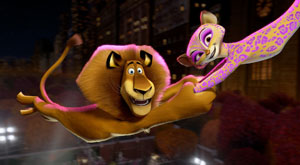 The tiger remains skeptical, tossing knives dangerously close to Alex and the gullible seal. But the seal in particular, and the leopard with slightly less enthusiasm, welcome the quartet aboard, with Julian and his group somehow including themselves in the welcome too. The seal is pleasantly surprised to learn that Alex and the others are from New York, stating that the circus is going there – they hope – as they are to audition before an American investor after playing their next engagement in Rome, for a chance at a U.S. tour booking. The tiger continues to snarl that including the newcomers in the show will not go over well with the circus owners. Who should drop through the ceiling of the railroad car but the penguins, announcing a surprise. With their winnings from Monte Carlo, and the front-man of their monkey dressed as the King of Versailles, they have just bought the circus – so they are now the new owners, and Alex, from his star experience as leader of the pack, is placed in charge of putting on the show. The tiger’s objections become abruptly stifled, though not his dislike of the group.
The tiger remains skeptical, tossing knives dangerously close to Alex and the gullible seal. But the seal in particular, and the leopard with slightly less enthusiasm, welcome the quartet aboard, with Julian and his group somehow including themselves in the welcome too. The seal is pleasantly surprised to learn that Alex and the others are from New York, stating that the circus is going there – they hope – as they are to audition before an American investor after playing their next engagement in Rome, for a chance at a U.S. tour booking. The tiger continues to snarl that including the newcomers in the show will not go over well with the circus owners. Who should drop through the ceiling of the railroad car but the penguins, announcing a surprise. With their winnings from Monte Carlo, and the front-man of their monkey dressed as the King of Versailles, they have just bought the circus – so they are now the new owners, and Alex, from his star experience as leader of the pack, is placed in charge of putting on the show. The tiger’s objections become abruptly stifled, though not his dislike of the group.
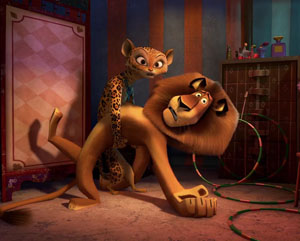 Alex tries to play it low-key, planning to just let the animal performers do what they do at their engagement in Rome, while he and the zoo animals stay in the background. But the leopard is not content to let Alex remain idle, seductively coaxing him to teach her trapeze Americano-style. Alex winds up doing rehearsal on the trapeze bar to back up his boast, awkwardly performing stunts like catching onto a platform with his teeth, and taking forceful bounces off nets and posts back onto the trapeze, which the leopard copies as all part of the act. The other zoo animals also seem discontented with taking a back seat to the performers, as Gloria tries to learn a high-wire dancing act with Melman (who has never danced nor walked a tightrope in his life), and Marty changes his stripes for polka-dots and a rainbow-colored Afro as a would-be dancing clown. King Julian meanwhile becomes involved in a side-plot, developing unexpected love at first sight when he is assigned to a box car with a drooling, roaring female bear riding a kids’ tricycle.
Alex tries to play it low-key, planning to just let the animal performers do what they do at their engagement in Rome, while he and the zoo animals stay in the background. But the leopard is not content to let Alex remain idle, seductively coaxing him to teach her trapeze Americano-style. Alex winds up doing rehearsal on the trapeze bar to back up his boast, awkwardly performing stunts like catching onto a platform with his teeth, and taking forceful bounces off nets and posts back onto the trapeze, which the leopard copies as all part of the act. The other zoo animals also seem discontented with taking a back seat to the performers, as Gloria tries to learn a high-wire dancing act with Melman (who has never danced nor walked a tightrope in his life), and Marty changes his stripes for polka-dots and a rainbow-colored Afro as a would-be dancing clown. King Julian meanwhile becomes involved in a side-plot, developing unexpected love at first sight when he is assigned to a box car with a drooling, roaring female bear riding a kids’ tricycle.
 The performance finally takes place, with tent pitched inside the ancient Roman Coliseum (an arena which Skipper the penguin refers to as a “dump”). However, the circus animals, now without the assistance of any human trainers or performers, all seem rusty and uncoordinated, and the show turns into a disaster, with an angry mob demanding their money back. (They get it, too, when a suitcase with the box-office receipts flings open as the animals flee for their train, the money flying everywhere into the air and then into the grabbing hands of the paying customers.) Julian’s romance with the bear also heats up, as they too make the train, but not until after an excursion to Vatican City, where Julian acquires an engagement ring for his “girl” by swiping it off the Pope’s finger as he bends to kiss it, then later hocks the ring to acquire a souped-up motorcycle for the bear when her tricycle gets busted, leaving the motorcycle dealer holding the bag when the cops arrive to reclaim the ring.
The performance finally takes place, with tent pitched inside the ancient Roman Coliseum (an arena which Skipper the penguin refers to as a “dump”). However, the circus animals, now without the assistance of any human trainers or performers, all seem rusty and uncoordinated, and the show turns into a disaster, with an angry mob demanding their money back. (They get it, too, when a suitcase with the box-office receipts flings open as the animals flee for their train, the money flying everywhere into the air and then into the grabbing hands of the paying customers.) Julian’s romance with the bear also heats up, as they too make the train, but not until after an excursion to Vatican City, where Julian acquires an engagement ring for his “girl” by swiping it off the Pope’s finger as he bends to kiss it, then later hocks the ring to acquire a souped-up motorcycle for the bear when her tricycle gets busted, leaving the motorcycle dealer holding the bag when the cops arrive to reclaim the ring.
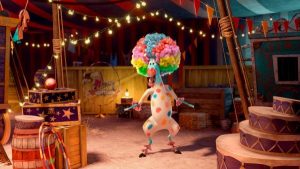 As the train chugs toward its next destination, Alex and everyone else see little hope that this troupe can impress the American investor, or that they will ever see New York again. The seal, however, calls Alex’s attention to a rear car of the train, which serves as a museum for memorabilia of the circus’s past. The seal relates a back-story of the show’s former glory, when the tiger was their star performer, accomplishing impossible feats in the art of jumping through hoops, in every performance calling for hoops progressively smaller and smaller in diameter, and utilizing his secret technique – of dousing his entire body in slippery olive oil to allow himself to slip through the increasingly-narrow diameter of each ring. He finally pushes the envelope too far one evening, calling for a finger-ring sized hoop, set on fire. He fails to reckon upon his olive-oil coating being flammable, and suffers severe burns that for a time leave him totally without fur. The luster of the circus fades with the loss of its star attraction, and the tiger never regains the confidence to resume his hoop-jumping act. The seal attributes the current lack of life in the performance to the overall loss of drive and of spirit of daring, now personified by the grumpy, disconsolate tiger, who refuses to take chances.
As the train chugs toward its next destination, Alex and everyone else see little hope that this troupe can impress the American investor, or that they will ever see New York again. The seal, however, calls Alex’s attention to a rear car of the train, which serves as a museum for memorabilia of the circus’s past. The seal relates a back-story of the show’s former glory, when the tiger was their star performer, accomplishing impossible feats in the art of jumping through hoops, in every performance calling for hoops progressively smaller and smaller in diameter, and utilizing his secret technique – of dousing his entire body in slippery olive oil to allow himself to slip through the increasingly-narrow diameter of each ring. He finally pushes the envelope too far one evening, calling for a finger-ring sized hoop, set on fire. He fails to reckon upon his olive-oil coating being flammable, and suffers severe burns that for a time leave him totally without fur. The luster of the circus fades with the loss of its star attraction, and the tiger never regains the confidence to resume his hoop-jumping act. The seal attributes the current lack of life in the performance to the overall loss of drive and of spirit of daring, now personified by the grumpy, disconsolate tiger, who refuses to take chances.
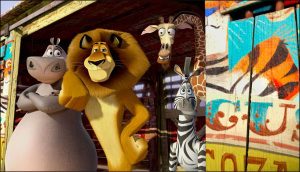 Alex does some brainstorming, and engages in a pep-talk with the circus troupe. Alex recalls how a group that now plays Vegas (a thinly-masked reference to Cirque De Soleil) revolutionized the concept of circus by dropping the animal acts. Well, why not the opposite? A revolutionary new-fangled circus consisting of, and entirely run by, animals? Alex puts his ideas into play, and into rehearsal, immediately. Many of the animals are recruited into acts only previously performed by humans (such as the seal as a human cannonball, in a cannon loaded with TNT sticks by the penguins). Alex’s zoo quartet also become integrally involved in the acts, with Gloria and Melman perfecting tight-wire dancing, and Marty, in the course of a rescue of the seal from a high cliff when the cannon overshoots its target, becoming a better cannonball than the seal, claiming that he can fly. Another encounter with Dubois, who has been doggedly following the railroad tracks with her sniffer to locate the troupe’s whereabouts, convinces Alex that they’re as ready as they’ll ever be for the performance before the American investor, and they hurry to their opening night. The show goes off wonderously, featuring visual spectacle and choreography akin to a Cirque De Soleil extravaganza, but with no humans involved. Alex and the leopard soar through the air and through multiple layers of lighting effects with their new “Americano” techniques. And even the tiger, who is ready to walk out on the performance in his recurring fear of facing the hoops again, is finally pep-talked by Alex just before showtime, with Alex’s breakthrough idea – substitute non-flammable hair conditioner for olive oil as a lubricant. The tiger faces his nemesis stunt with the flaming ring – and succeeds without mishap, to the ovation of the crowd. The investor hands the “King of Versailles” a fat contract for the U.S. tour, with first stop, New York.
Alex does some brainstorming, and engages in a pep-talk with the circus troupe. Alex recalls how a group that now plays Vegas (a thinly-masked reference to Cirque De Soleil) revolutionized the concept of circus by dropping the animal acts. Well, why not the opposite? A revolutionary new-fangled circus consisting of, and entirely run by, animals? Alex puts his ideas into play, and into rehearsal, immediately. Many of the animals are recruited into acts only previously performed by humans (such as the seal as a human cannonball, in a cannon loaded with TNT sticks by the penguins). Alex’s zoo quartet also become integrally involved in the acts, with Gloria and Melman perfecting tight-wire dancing, and Marty, in the course of a rescue of the seal from a high cliff when the cannon overshoots its target, becoming a better cannonball than the seal, claiming that he can fly. Another encounter with Dubois, who has been doggedly following the railroad tracks with her sniffer to locate the troupe’s whereabouts, convinces Alex that they’re as ready as they’ll ever be for the performance before the American investor, and they hurry to their opening night. The show goes off wonderously, featuring visual spectacle and choreography akin to a Cirque De Soleil extravaganza, but with no humans involved. Alex and the leopard soar through the air and through multiple layers of lighting effects with their new “Americano” techniques. And even the tiger, who is ready to walk out on the performance in his recurring fear of facing the hoops again, is finally pep-talked by Alex just before showtime, with Alex’s breakthrough idea – substitute non-flammable hair conditioner for olive oil as a lubricant. The tiger faces his nemesis stunt with the flaming ring – and succeeds without mishap, to the ovation of the crowd. The investor hands the “King of Versailles” a fat contract for the U.S. tour, with first stop, New York.
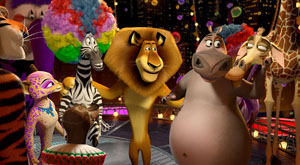
Left to right: Vitaly the Tiger (Bryan Cranston), Gia the Jaguar (Jessica Chastain), Marty the Zebra (Chris Rock), Alex the Lion (Ben Stiller), Gloria the Hippo (Jada Pinkett Smith) and Melman the Giraffe (David Schwimmer) are a circus success in DreamWorks Animation’s MADAGASCAR 3: EUROPE’S MOST WANTED, released by Paramount Pictures.
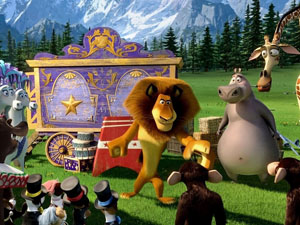 The zoo quartet arrive outside the gates of their old zoo home. Looking through the closed gates after-hours, they seem to view their old habitats as smaller than remembered, and the place seems lifeless with no crowds around. Even the wall murals don’t seem to depict accurately life in the wild as they found it. Each of them realize that they felt truly alive when they were with the circus, when life was charged with excitement and danger – and the gang mutually decide to return to the show, offer apologies, and see if they can make their way back in. Their idea, however, is cut short by a massive volley of tranquilizer darts. Dubois has once again caught up, following them across an ocean. She is about to utilize a stiletto knife to sever Alex’s groggy head, when some zoo guards discover the group outside the gate. The guards presume Dubois brought back their beloved Alex and the others, and the four animals awaken next morning to find themselves back within their old enclosures, but with high fences surrounding each to prevent their further escape. Dubois s hailed as a heroine, and presented with a large oversized reward check from the zoo in a public ceremony. But Dubois will not be denied her own personal victory. “This was never about the money”, she declares, as she tears the check in two. “It was about the lion.” She raises her tranquilizer dart gun, turning to face Alex atop his rock. However, she loads a special dart into the chamber – one marked in skull and crossbones as poison. The dart flies, crowd or no crowd, but Alex uses his trapeze training to dodge out of its way at the last possible second. Then reinforcements arrive. Flying over the zoo in a multi-colored balloon comes the circus cast, who have retained the Cirque-de-Soleil style inspired by the gang, adding to it Marty’s outlandish clown attire, renaming the troupe the “Afro Circus”. As performers swoop down to rescue Alex and the gang from their enclosures, a wild finale takes place, considerably beyond comprehensive description in these pages, in which various circus tactics are employed to outwit and out-maneuver Dubois, including interference by the cannonball act, ring-jumping by the tiger with Marty in hand, and the motorcycle riding duo of the bear and Julian, culminating in a final shot by Mort, the littlest lemur of Julian’s entourage, from Dubois’s tranquilizer gun, nailing her in the neck with a powerful dose of her own medicine. When Dubois awakens, she finds herself nailed inside a crate, on board an ocean vessel, heading for – where else – Madagascar. As in many a Dreamworks picture, a happy dancing sequence closes out the show, as Alex and company, all in Afros, choose the life of the circus as their new and exciting home.
The zoo quartet arrive outside the gates of their old zoo home. Looking through the closed gates after-hours, they seem to view their old habitats as smaller than remembered, and the place seems lifeless with no crowds around. Even the wall murals don’t seem to depict accurately life in the wild as they found it. Each of them realize that they felt truly alive when they were with the circus, when life was charged with excitement and danger – and the gang mutually decide to return to the show, offer apologies, and see if they can make their way back in. Their idea, however, is cut short by a massive volley of tranquilizer darts. Dubois has once again caught up, following them across an ocean. She is about to utilize a stiletto knife to sever Alex’s groggy head, when some zoo guards discover the group outside the gate. The guards presume Dubois brought back their beloved Alex and the others, and the four animals awaken next morning to find themselves back within their old enclosures, but with high fences surrounding each to prevent their further escape. Dubois s hailed as a heroine, and presented with a large oversized reward check from the zoo in a public ceremony. But Dubois will not be denied her own personal victory. “This was never about the money”, she declares, as she tears the check in two. “It was about the lion.” She raises her tranquilizer dart gun, turning to face Alex atop his rock. However, she loads a special dart into the chamber – one marked in skull and crossbones as poison. The dart flies, crowd or no crowd, but Alex uses his trapeze training to dodge out of its way at the last possible second. Then reinforcements arrive. Flying over the zoo in a multi-colored balloon comes the circus cast, who have retained the Cirque-de-Soleil style inspired by the gang, adding to it Marty’s outlandish clown attire, renaming the troupe the “Afro Circus”. As performers swoop down to rescue Alex and the gang from their enclosures, a wild finale takes place, considerably beyond comprehensive description in these pages, in which various circus tactics are employed to outwit and out-maneuver Dubois, including interference by the cannonball act, ring-jumping by the tiger with Marty in hand, and the motorcycle riding duo of the bear and Julian, culminating in a final shot by Mort, the littlest lemur of Julian’s entourage, from Dubois’s tranquilizer gun, nailing her in the neck with a powerful dose of her own medicine. When Dubois awakens, she finds herself nailed inside a crate, on board an ocean vessel, heading for – where else – Madagascar. As in many a Dreamworks picture, a happy dancing sequence closes out the show, as Alex and company, all in Afros, choose the life of the circus as their new and exciting home.
 We finally close with Tim Burton’s live-action/CGI semi-remake of Dumbo (Disney, 3/11/19). It could almost be called a Dumbo double-feature, the first half tracking rather closely the animated original, while the second half adds a new story about what happens once Dumbo becomes a star. The first half, converting to a realistic live-action format, has to of course make some substantive changes to give the production an appearance of believability. Mrs. Jumbo expects childbirth in a normal real-life manner, but a nice touch harkens back to memories of Disney’s fantasy, as, at precisely the moment when Mrs. Jumbo gives birth, the shadow of a stork is projected by the moonlit sky, passing across the enclosure where she is housed. Timothy Mouse is almost written out of the script (the crows disappearing entirely), and only appears briefly as a costumed pet mouse among a cage of other mice owned by one of the rwo children who take their place as Dumbo’s future mentors. The pink elephants are also difficult to figure into a screenplay attempting to give the impression of real life – yet are also penciled in by way of another Cirque De Soleil-style dance performance within the show, where their images are produced for brief fleeting moments as oversized soap bubbles produced from large rings swung about by the dancers, and lit with pink spotlights during the performance.
We finally close with Tim Burton’s live-action/CGI semi-remake of Dumbo (Disney, 3/11/19). It could almost be called a Dumbo double-feature, the first half tracking rather closely the animated original, while the second half adds a new story about what happens once Dumbo becomes a star. The first half, converting to a realistic live-action format, has to of course make some substantive changes to give the production an appearance of believability. Mrs. Jumbo expects childbirth in a normal real-life manner, but a nice touch harkens back to memories of Disney’s fantasy, as, at precisely the moment when Mrs. Jumbo gives birth, the shadow of a stork is projected by the moonlit sky, passing across the enclosure where she is housed. Timothy Mouse is almost written out of the script (the crows disappearing entirely), and only appears briefly as a costumed pet mouse among a cage of other mice owned by one of the rwo children who take their place as Dumbo’s future mentors. The pink elephants are also difficult to figure into a screenplay attempting to give the impression of real life – yet are also penciled in by way of another Cirque De Soleil-style dance performance within the show, where their images are produced for brief fleeting moments as oversized soap bubbles produced from large rings swung about by the dancers, and lit with pink spotlights during the performance.
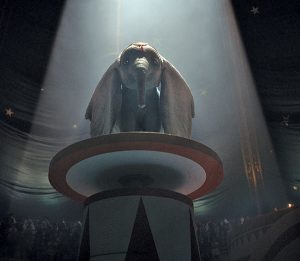 Certain themes are carried into the second half of the film beyond their use in the original. The “magic feather”, accidently introduced to Dumbo during his early days and inducing his first sneeze that sends him momentarily aloft, continues to be Dumbo’s impetus to fly, almost until the end of the picture. Mom’s incarceration from attempting to protect her son further continues well into the second half, even after Dumbo has become a star. Here, a rival circus proprietor with considerable wealth named Vandermeer hears of Dumbo’s triumphant solo flight in the Medici Family Circus. The latter small circus has been hitting hard times, and despite its new star attraction, Vandermeer offers a deal that Medici can’t refuse. Vandermeer has visions that the traveling circus is becoming a thing of the past, and plans to build such shows into a permanent attraction where the audience comes to them. Much in the manner of the studio’s founder Walt, Vandermeer proposes the creation of a circus world theme park called Dreamland. And. If Medici will sell Dumbo and the show to him, Medici will receive a junior stockholding in the company, an executive vice-president position, and permanent jobs for all his employees at the park. Medici can’t turn the offer down. Dumbo receives advance billing as the center attraction in the park’s big-top coliseum. However, before Dumbo had his first flight with the Medici show, Medici had sold Mrs. Jumbo as a threat to the public, her whereabouts presently unknown. It is discovered as the story progresses that Vandermeer had already acquired Mrs. Jumbo as an addition for a projected attraction in Dreamland – part of an exhibition of the world’s most dangerous animals, called “Nightmare Island”.
Certain themes are carried into the second half of the film beyond their use in the original. The “magic feather”, accidently introduced to Dumbo during his early days and inducing his first sneeze that sends him momentarily aloft, continues to be Dumbo’s impetus to fly, almost until the end of the picture. Mom’s incarceration from attempting to protect her son further continues well into the second half, even after Dumbo has become a star. Here, a rival circus proprietor with considerable wealth named Vandermeer hears of Dumbo’s triumphant solo flight in the Medici Family Circus. The latter small circus has been hitting hard times, and despite its new star attraction, Vandermeer offers a deal that Medici can’t refuse. Vandermeer has visions that the traveling circus is becoming a thing of the past, and plans to build such shows into a permanent attraction where the audience comes to them. Much in the manner of the studio’s founder Walt, Vandermeer proposes the creation of a circus world theme park called Dreamland. And. If Medici will sell Dumbo and the show to him, Medici will receive a junior stockholding in the company, an executive vice-president position, and permanent jobs for all his employees at the park. Medici can’t turn the offer down. Dumbo receives advance billing as the center attraction in the park’s big-top coliseum. However, before Dumbo had his first flight with the Medici show, Medici had sold Mrs. Jumbo as a threat to the public, her whereabouts presently unknown. It is discovered as the story progresses that Vandermeer had already acquired Mrs. Jumbo as an addition for a projected attraction in Dreamland – part of an exhibition of the world’s most dangerous animals, called “Nightmare Island”.
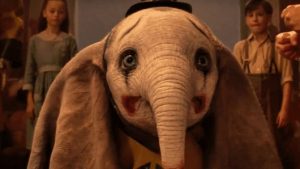 To complicate matter, Vandermeer wants Dumbo to perform a doubles act, carrying a trapeze girl atop him bareback. Dumbo’s trainer, the father of the two children who taught him to fly, believes Dumbo should only work as a single, and rehearsals don’t go well, the rider unable to figure out how to link up with Dumbo high above the crowd, intimidated by his mammoth weight whizzing by, causing both her and Dumbo to fall into the safety net below. Mounting is finally figured out by having Dumbo lifted high above the arena on an elevator platform, where the trapeze girl joins him. A debut for the act is scheduled, with a bank officer present from whom Vandermeer hopes to obtain substantial loans for future operation of the park. Medici has no voice in the proceedings, finding his vice-presidency ro be a mere figurehead position with no say in the conducting of operations. The girl mounts Dumbo’s back, passing him the feather, which Dumbo sucks into his trunk. Once again, the feather makes him sneeze, causing the girl to slide off his back, clinging desperately to the platform. Without advance-warning to her or anyone else, Vandermeer has taken the liberty of instructing the stagehands not to put up the safety nets, to increase the danger angle of the show. Only some fancy roping from the trainer/father saves the girl’s life. Dumbo too struggles to stay atop the platform, losing his footing. He trumpets for help, and to his surprise hears the distant resposive trumpet of his mother. Dumbo falls, but manages to right himself in mid-air, soaring safely a few times around the tent. But then, Dumbo unexpectedly sails out the tent entrance, heading for the sound of his mother at Nightmare Island. The bank officer isn’t impressed with the chaos and unexpected ending to the show, and announces that “The bank is closed” until Vandermeer works out the bugs from his show. Considering Mrs. Jumbo to be an expendable distraction to Dumbo’s career, Vandermeer closes the Nightmare Island attraction, and secretly orders Mrs. Jumbo to be destroyed.
To complicate matter, Vandermeer wants Dumbo to perform a doubles act, carrying a trapeze girl atop him bareback. Dumbo’s trainer, the father of the two children who taught him to fly, believes Dumbo should only work as a single, and rehearsals don’t go well, the rider unable to figure out how to link up with Dumbo high above the crowd, intimidated by his mammoth weight whizzing by, causing both her and Dumbo to fall into the safety net below. Mounting is finally figured out by having Dumbo lifted high above the arena on an elevator platform, where the trapeze girl joins him. A debut for the act is scheduled, with a bank officer present from whom Vandermeer hopes to obtain substantial loans for future operation of the park. Medici has no voice in the proceedings, finding his vice-presidency ro be a mere figurehead position with no say in the conducting of operations. The girl mounts Dumbo’s back, passing him the feather, which Dumbo sucks into his trunk. Once again, the feather makes him sneeze, causing the girl to slide off his back, clinging desperately to the platform. Without advance-warning to her or anyone else, Vandermeer has taken the liberty of instructing the stagehands not to put up the safety nets, to increase the danger angle of the show. Only some fancy roping from the trainer/father saves the girl’s life. Dumbo too struggles to stay atop the platform, losing his footing. He trumpets for help, and to his surprise hears the distant resposive trumpet of his mother. Dumbo falls, but manages to right himself in mid-air, soaring safely a few times around the tent. But then, Dumbo unexpectedly sails out the tent entrance, heading for the sound of his mother at Nightmare Island. The bank officer isn’t impressed with the chaos and unexpected ending to the show, and announces that “The bank is closed” until Vandermeer works out the bugs from his show. Considering Mrs. Jumbo to be an expendable distraction to Dumbo’s career, Vandermeer closes the Nightmare Island attraction, and secretly orders Mrs. Jumbo to be destroyed.
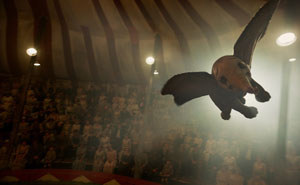 In the last portions of the film, the plot to exterminate Mrs. Jumbo is uncovered, and Medici, the children and their father, the former Medici performers, and even Dumbo‘s flying partner, unite in an elaborate scheme to set both Mrs. Jumbo and Dumbo free. The circus performers set up a break-in to Nightmare Island, getting the cell in which Mrs. Jumbo is housed open, but needing the throwing of a power switch to disable security devices to get her out of the compound. The father and trapeze girl work on that angle, the girl appearing in a second performance to get the flying act right, while the father scales the top of the circus tent, cutting a large flap of canvas sufficient to permit an elephant-sized opening above. The girl and Dumbo successfully launch themselves in flight, while the father opens the tent flap, permitting them to soar through the roof into the night sky. They head to a tall command tower which houses the central power room for the park. Dumbo lands on an exterior landing of the tower, and he and the girl enter, surprising the personnel as they take over the control panel, pulling switches all across the board to throw the park into darkness. Vandermeer is livid, while the circus performers succeed in setting Mrs. Jumbo free. Vandermeer soon tracks down the source of the outage, and while the girl and Dumbo attempt to escape, Vandermeer, in a rage, commands that he needs light. His staff from the power room attempt to warm him that start-up requires recalibration, and that random flicking of switches runs the risk of massive power surges. But Vandermeer doesn’t care, whacking switches into on position everywhere. As predicted, a fire erupts in the main tent. The children and their father wind up trapped inside. When Dumbo and the girl learn that gather and kids have not come out of the park, Dumbo bravely soars in through the partially-flaming tent entrance that has prevented the father and children from making an exit. Dumbo safely gets them out by squirting water from his trunk to clear a small path through the exit – but in the process loses the feather, watching it burn up from contact with falling embers. Vandermeer and his men are approaching, so the kids mount Dumbo, and give him the Timothy Mouse speech about the feather not really being necessary to accomplish his miracle of flight. Dumbo finally gets it, and takes off, with the kids piloting him to the docks where Mrs. Jumbo waits, bound for a steamship to take the two of them back to Asia. The father escapes Vandermeer on horseback, and Medici and the bank officer gloat at Vandermeer’s “bigger troubles”, as all of Dreamland is consumed in flame.
In the last portions of the film, the plot to exterminate Mrs. Jumbo is uncovered, and Medici, the children and their father, the former Medici performers, and even Dumbo‘s flying partner, unite in an elaborate scheme to set both Mrs. Jumbo and Dumbo free. The circus performers set up a break-in to Nightmare Island, getting the cell in which Mrs. Jumbo is housed open, but needing the throwing of a power switch to disable security devices to get her out of the compound. The father and trapeze girl work on that angle, the girl appearing in a second performance to get the flying act right, while the father scales the top of the circus tent, cutting a large flap of canvas sufficient to permit an elephant-sized opening above. The girl and Dumbo successfully launch themselves in flight, while the father opens the tent flap, permitting them to soar through the roof into the night sky. They head to a tall command tower which houses the central power room for the park. Dumbo lands on an exterior landing of the tower, and he and the girl enter, surprising the personnel as they take over the control panel, pulling switches all across the board to throw the park into darkness. Vandermeer is livid, while the circus performers succeed in setting Mrs. Jumbo free. Vandermeer soon tracks down the source of the outage, and while the girl and Dumbo attempt to escape, Vandermeer, in a rage, commands that he needs light. His staff from the power room attempt to warm him that start-up requires recalibration, and that random flicking of switches runs the risk of massive power surges. But Vandermeer doesn’t care, whacking switches into on position everywhere. As predicted, a fire erupts in the main tent. The children and their father wind up trapped inside. When Dumbo and the girl learn that gather and kids have not come out of the park, Dumbo bravely soars in through the partially-flaming tent entrance that has prevented the father and children from making an exit. Dumbo safely gets them out by squirting water from his trunk to clear a small path through the exit – but in the process loses the feather, watching it burn up from contact with falling embers. Vandermeer and his men are approaching, so the kids mount Dumbo, and give him the Timothy Mouse speech about the feather not really being necessary to accomplish his miracle of flight. Dumbo finally gets it, and takes off, with the kids piloting him to the docks where Mrs. Jumbo waits, bound for a steamship to take the two of them back to Asia. The father escapes Vandermeer on horseback, and Medici and the bank officer gloat at Vandermeer’s “bigger troubles”, as all of Dreamland is consumed in flame.
Medici reopens on his own, with a new circus that, politically correctly, does not exploit animals, but features human performers in animal costumes. Half a world away, Dumbo and Mom enter a world of majestic jungle freedom, heralded by the trumpets of other elephants, as Dumbo soars high above them all, then back to his mother’s embracing trunk, for the fade out.
Bring down the house lights. The show is over. Next week we return to the Golden Age of Animation – with a new topic.


 Charles Gardner is an animation enthusiast who toils by day as a member of LA Law – but by nights and weekends indulges in classic jazz and ragtime as a performer; and studies classic Hollywood cartoons… maybe a little too much.
Charles Gardner is an animation enthusiast who toils by day as a member of LA Law – but by nights and weekends indulges in classic jazz and ragtime as a performer; and studies classic Hollywood cartoons… maybe a little too much.


































































































































































I’m still waiting for a sequel to “The Black Cauldron”.
I was hoping you might get around to discussing “The Amazing Digital Circus”, for which I’ve been getting YouTube recommendations regularly since last year. The pilot was first posted online in 2023 and quickly garnered hundreds of millions of views, as has the second (and, to date, the only other) episode. The Amazing Digital Circus is a virtual world presided over by a ringmaster who’s mostly eyes and teeth. While playing a game, several people have gotten sucked into this world, where they are incarnated as their avatars. There is apparently no escape from the Amazing Digital Circus — or is there?
A certain “Gooseworx” is credited as the creator, writer, composer, and numerous etceteras, but I have no idea if “Gooseworx” is a person, a studio, a company, an artificial intelligence, or something else. The animation was done by a new Australian studio called Glitch Productions, but the vocal tracks, to judge by the accents, seem to have been recorded in North America. Also, in addition to the two official episodes, there are literally hundreds of homemade fan videos, most of them using flash animation rather than the CGI of the official productions.
I’m not a gamer myself, so “The Amazing Digital Circus” isn’t really my bag of peanuts. Still, I’d be grateful if anyone with additional information could help me make sense of it. Like it or not, “The Amazing Digital Circus” is where we have landed after over a century’s worth of circus cartoons.
Gooseworx is an individual, to clarify. Many of those 2D animations have been classified as “engagement farm” content; essentially, poaching the immense success of the show rather than chasing any sincerity as a fanwork. Yes, the voices are done in North America, some of them having worked on productions for large corporations. While I’m certainly not a superfan, I am fond of what they’re doing and am happy for their flash in the pan success, considering the studio started out as one kid goofing around with Super Mario 64 footage.
For the record, the animation feature division were NOT involved with the Direct-to-Video films but by the television animation’s Spin-off division, Toons Studios, which is partly why the writing was not up to theatrical standards. When John came to the studio, he helped put the end of the practice (which at that point, almost did sequels to Pixar originated films), citing that it cheapened the reputation of the original films.
The original “Dumbo” movie is a breezy delight; the remake is leaden and labored, with inordinate focus on the humans in an effort to make the story about girl power rather than the baby elephant who learns to believe in himself and his talent.
I haven’t seen Madagascar 3 in full, but I was directly in the demographic it was being marketed to when it came out. There’s a generation of working adults who have Chris Rock’s Afro Circus performance seared into their brains because every trailer and commercial had the scene. Plus: remember that Nickelodeon and Cartoon Network were repetitive in their ad breaks–same promos, same commercials, every break.
As an adult, I now live with the knowledge that Noah Baumbach (Marriage Story, Barbie) was brought in to rewrite the script. Speaking of Marriage Story, based on true events in his life, I’ve heard that he took the job to help pay for his divorce. Unsure if anyone’s ever confirmed, but I could believe it.
An early DVD release of “Dumbo” had a bonus feature about the making of a direct-to-video sequel, in which Dumbo would be joined by other circus critters and a talking Casey Junior. Evidently that never got to animation.
Also, in the early days of the Disney Channel, “Dumbo’s Circus” placed him in a storybook world with a tiny traveling show. It was a little like early Krofft, but with no humans among the costumes and puppets.
There was a trend running parallel to the direct-to-video sequels: TV series, often set as sequels to the movies and sometimes using a direct-to-video as an origin episode (the one for Aladdin explained the genie and Iago returning). Disney didn’t have a monopoly here — series became a popular way of keeping a franchise alive between movies.
It is certainly true that Dreamworks has been no stranger to utilizing TV series, and specials, to bolster its franchises. Witness multiple holiday specials with the Madagascar cast, “The Penguins of Madagascar” TV series, holiday special, and theatrical spinoff, and the TV series, “Hail, King Julian”.
By the way, I didn’t include “The Amazing Digital Circus” because it was of too recent origin for the time period I generally cover for shorts and TV series in these articles (Jerry prefers discussion of pre-2000 productions), and because I really didn’t see the series as having that much to really do with circuses, including in it no circus acts, but just a backdrop setting for the digital nightmare of being stuck in a computer program. It’s kind of a quirky show, but overall from what I’ve seen, it has respectable writing and a certain appeal, in a dark-humor sort of Halloweeny way. I think my favorite gag so far was choosing new arrivals’ names by a letter-wheel slot machine – whether or not the displayed result included any vowels.